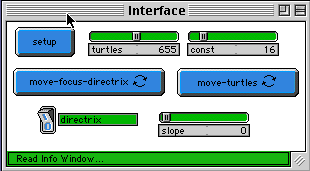
WHAT IS IT? ----------- The model displays two basic conic sections: hyperbolas and parabolas. The figures are generated behaviorally as opposed to algebraically- the turtles attempt to behave like points on the specified shape. The partner to this model is called 'Conic Sections-circle&ellipse.' The turtles use feedback to make decisions about how they behave. They set out in random directions, and then they receive information as to whether or not they are getting closer to where they want to be. If they are getting closer, they continue moving forward in the direction they are going. If they are moving farther away, they set out in a new random direction. This process is akin to the children's game of "Hot & Cold", in which players are told whether they are getting "hotter" or "colder" in relation to a hidden goal. HOW TO USE IT ------------- *Hyperbolas: -Select the number of turtles with the TURTLES slider. -Press SETUP. -Make sure the DIRECTRIX switch is set to 1. -Press the MOVE-FOCUS-DIRECTRIX button to select the two foci as for ellipses. -Press MOVE-TURTLES. Adjust CONSTANT and pick new foci as desired. *Parabolas: -Select the number of turtles with the TURTLES slider. -Press SETUP. -Make sure the DIRECTRIX switch is set to 0. -Press the MOVE-FOCUS-DIRECTRIX button. After this, select first the position of the focus, and then a point through which the directrix will pass. The SLOPE slider sets the slope of the directrix. -Press MOVE-TURTLES. You can use the slope slider to change the slope of the directrix. -Note that CONSTANT has no effect on the parabola. THINGS TO NOTICE ---------------- When forming a hyperbola, turtles adjust their positions from two user-defined foci so that the difference between their distances from the foci attains a value of CONSTANT. When forming a parabola, turtles move until their distance from the directrix, measured perpendicularly, is the same as their distance to the focus. In some cases, the turtles cannot satisfy the rule. In this case, they keep looking and never settle down. Look for examples of this with a hyperbola. THINGS TO TRY ------------- Adjust the slope of the parabola's directrix or the value of CONSTANT for the hyperbola while the turtles are still moving. See how they react to the changes in their environment. You may be able to get a better feeling for the turtles' behavior if only a few turtles are on-screen at one time. Try setting num to a small value (like 16 or 1), and watching the turtles. EXTENDING THE MODEL ------------------- Look at the StarLogoT model Turtles Circling. Watch how the turtles react with each other- something that is missing from 'Conic Sections'. Implement this emergent behavior for one or all of the conics in this project. STARLOGOT FEATURES ----------------- Like more traditional programming languages (e.g. C++), StarLogoT can have functions that return a value to the calling function. The command used is called 'output'- it has one argument, the value to be returned. Look at the function 'minus'. It takes one argument, num, and returns its negative, 0 - num. (The colon preceding num indicates that num is a local variable sent to the called function.)